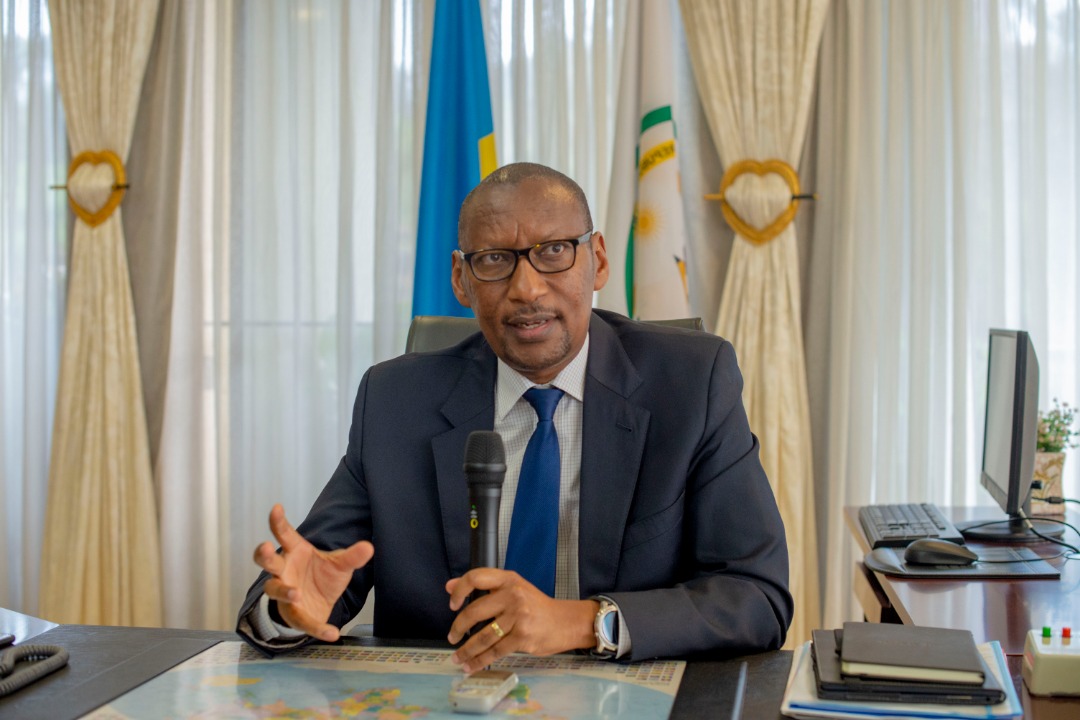
John Rwangombwa, Governor of National Bank of Rwanda
Increasing levels of external debt among African countries and the need for monetary measures to keep debt levels manageable will be one of the key items on the agenda as Central Bank Governors from across the continent convene in Kigali.
According the Governor of the National Bank of Rwanda (BNR) John Rwangombwa, a one day symposium of the Association of African Central Banks (AACB), which precedes the 42nd Ordinary Meeting of the Assembly of Governors, will discuss how the continent can sustainably and effectively manage debt to achieve long term development targets without endangering economies.
According to Rwangombwa, the symposium, which will bring together central bank governors and other high ranking officials from 41 central banks across the continent, will focus on the trending topic of sovereign debt which threatens to affect the economic growth and stability of the continent.
“This year we agreed to focus our discussion on the rising sovereign debt in Africa and its possible impact on the monetary policy and financial stability of our economies,” Rwangombwa said.
There are growing concerns that African countries are accumulating external debt which has been steadily increasing at an average of 10 percent since 2010, reaching almost 40 percent of Gross Domestic Product (GDP) in 2017.
Public debt on the African continent stood at 45 percent of GDP at the end of 2017 compared to 29.1 percent in 2013. According to the World Bank’s Africa Pulse 2017 report, 11 out of 35 low income countries in Sub-Saharan Africa are classified as high risk of debt distress.
These countries are at high risk of getting overly indebted if they continue taking loans. The World Bank’s 2018 report further shows that at least 40 per cent of countries in Sub Saharan Africa are in danger of getting into a major sovereign debt crisis, with 18 countries now at high risk of debt distress, which is more than double compared to 2013.
Eight of those countries are already in distress. The meeting in Kigali will seek to find ways of how African countries can continue to sustainably borrow and repay the debts without sinking into indebtedness.
Experts say that if the debt levels are not well managed, the continent could spiral into a debt crisis, even though most countries remain under the 45 per cent debt-to-GDP ratio, with the threshold set at 60 per cent.
Heavy borrowing to finance infrastructure projects and increasing depreciation of domestic currencies are mainly blamed for increasing indebtedness, with countries having to pay back a significant portion of the debt denominated in foreign currencies, mainly the US dollars and euros.
According to the Ministry of Finance and Economic Planning, Rwanda’s debt remains low with a present value of debt to GDP reaching 32.9 per cent, against a threshold of 50 per cent.
The share of concessional loans in the total debt stock stood at 63 per cent as of end 2018 compared to a level of 57.4 per cent as of end 2017. This is attributed to the country’s debt strategy to maximize concessional borrowing in favor of commercial borrowing.
Optimism remains, no debt crisis
Despite the debt concerns, at 45 per cent average debt, Rwangombwa says that most African countries remain in a healthy position to sustainably borrow more than some developed countries, as long as they can wisely invest in key projects.
“Normally 45 per cent for Africa would sound low but the big concern has been from two angles –it has been rising sort of exponentially. We were at around 25 per cent in 2008, so that is about 20 per cent increase in just 10 years,” Rwangombwa said.
He also pointed out that the nature of the debt has evolved, with countries moving from taking concessional loans to taking commercial loans such as bonds which are high on interest and more risky, compared to concessional loans which are issued by development finance institutions and given at low interest rates and more favourable terms.
“From 2009 onwards, we’ve seen many African countries go to the Eurobond market. Now it is a mix of commercial debt that is a bit heavy on the books for different countries,”
“We are not yet really in any debt crisis at all. Some countries, either one or two, have faced a bit of a challenge but overall, there is no crisis,” Rwangombwa said adding that though the situation has not spiraled out of control, the main objective of the meeting in Kigali is to discuss how African countries can sustainably manage debt and avoid a scenario of the indebtedness in the 90’s.
There have been concerns that African countries are borrowing too much. The continent’s eurobond debt surpassed the $100-billion mark earlier this year after Ghana issued $2.7 billion bond. In 2018 alone African countries issued Eurobonds worth $27.1 billion.

Governor of central bank John Rwangombwa responds to questions of KT Press’ Edmund Kagire
According to the Brookings Institution, the average total debt-to-GDP ratio for African countries stands at 53 per cent compared with 90 percent during 90’s debt crisis, which makes African economies still fit to borrow but the institution warns that the rate at which countries are getting indebted is what is worrisome.
Rwangombwa however says that while the concerns are genuine, debt sustainability by the countries and how they wisely invest the money will make the difference. There have been concerns that some countries have been quick to issue Eurobonds but mismanaged the money.
The Central Bank Governor says that with African Continental Free Trade Area (AfCFTA) coming into force, Africa is positioned to create more potentials to borrow and invest in infrastructure development and boost the confidence of investors to put more money in the continent.
It is feared that if the current and growing trend of sovereign debt continues, public debt can reach a level where its fiscal sustainability is potentially threatened, affecting the monetary policy in the process, as countries continue to borrow to fill deficit gaps.
The decline in commodity prices, the stagnation of official development assistance and increased use of debt to finance infrastructure and social sectors is partly blamed for increasing indebtedness.
With Chinese debt growing from $10bn in 2010 to $30bn in 2016 on the African continent and another $60bn announced by Chinese President Xi Jinping last year, experts have warned that African countries are increasingly getting themselves debt trapped.
Governor Rwangombwa however dismissed the fears, pointing out that the problem is not the Chinese but rather African countries which do not negotiate good terms, adding that some countries have been able to borrow from China and effectively use the loans for infrastructure development.
He said in some case countries take poorly negotiated short term commercial loans which in the end become a burden on them.
The Wednesday symposium which is aimed at promoting exchanges among central bank Governors, policy-makers, international institutions and the academia will bring together renowned economists and minds.
They include Abebe Aemro Selassie, the Director of the African Department at the International Monetary Fund (IMF), Prof. Victor Harison, the Commissioner for Economic Affairs, African Union Commission and Dr. Kaberuka Donald, the Chairman, SouthBridge and Former President of African Development Bank (AfDB).

